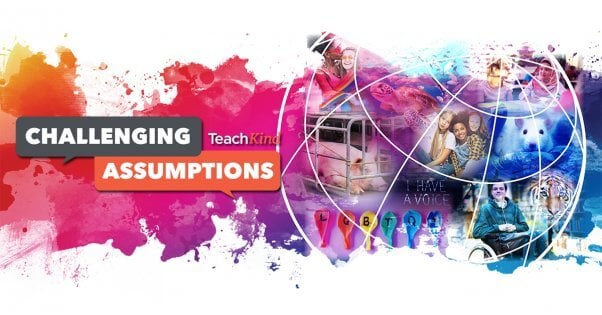Teaching With Film: ‘Breaking the Chain’ Discussion Questions
Every day, animals in our communities need our help—and you can open your students’ eyes to what life is really like for these animals by screening Breaking the Chain, a new documentary from executive producer Anjelica Huston that spotlights the work of PETA’s Community Animal Project. Fieldworkers visit impoverished areas of Virginia and North Carolina to care for mistreated animals who—without their help—would continue to suffer or even die. The film depicts the real-life, everyday work on the front line of the animal neglect and overpopulation crisis as it follows the heroes who are dedicated to saving the less fortunate and alleviating animal suffering.
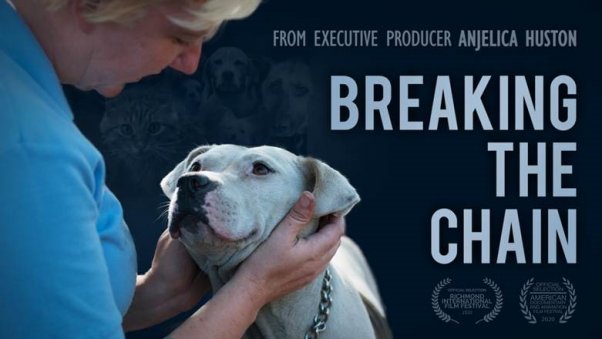
This eye-opening film explores the uphill battle that faces neglected animals as well as the people who dedicate their careers to helping them—and it can show your students ways they can make a difference for animals in their community, too. The film is currently streaming on Prime Video and available to rent or purchase across all other video-on-demand services—including Apple TV, iTunes, Google Play, Vudu, and Vimeo On Demand.
View this documentary as a class, then use the discussion questions below to help students understand the information and examine the ideas presented. (If you’re teaching virtually, you can have students watch the film independently and then discuss their responses to the questions as a class using popular online conferencing tools like Zoom or Skype. If these tools aren’t available to you, you could have students chat about the film and the discussion questions in an online forum, such as Google Classroom.) Depending on the needs and abilities of your students, you may want to pause the film to discuss the questions as a group or have students respond to them in writing after watching the documentary.
What are some reasons why so many dogs and other animals are being neglected in the specific areas of Virginia and North Carolina where the film takes place?
There are multiple factors that play into the reasons why people mistreat their animals. Many people in these areas are impoverished and don’t have the resources to take good care of them. Unfortunately, in these communities, it’s common to chain dogs outdoors, and sometimes owners forget about them. Breeding and dogfighting are also common in these areas. Some residents use their dogs as “alarm systems” for their home. People generally mistreat their animals this way because that’s what they observed growing up and it’s seen as culturally acceptable in their community. When young people grow up seeing dogs mistreated, many of them assume that it’s normal and go on to treat their own dogs this way, continuing the cycle of neglect. The law is often not on the animals’ side in these areas—in many places, it’s still legal to chain dogs outside 24/7. PETA actively works to pass legislation to ban tethering, teach people about proper care of animal companions, and change cultural norms.
Why is it harmful for dogs to be chained outdoors 24/7?
Dogs chained outdoors have to suffer through all weather extremes, including cold snaps (during which their water could freeze), ice storms, hurricanes, snow, freezing rain, and wind—and in the summer, thunderstorms and sweltering temperatures of 100 degrees or more (although anything over 85 degrees can be dangerous to dogs, especially if they don’t have adequate shade, shelter, and water). Dogs are social animals who want to live indoors with their families. When left outside, they can be stolen and used for dogfighting. Chained dogs are also vulnerable to other animals and cruel humans, and their chains often get tangled, which can be deadly if they’re prevented from reaching food, water, shelter, or shade.
Describe what a typical day looks like for one of PETA’s Community Animal Project fieldworkers. What are some of the services fieldworkers provide?
Fieldworkers respond to calls from the community regarding animals in need and check in on animals they’ve visited before. They deliver food, water, doghouses, straw, new lightweight tie-outs (to replace heavy chains), toys, and other supplies to dogs. They speak with their owners to teach proper animal care. They also pick up and drop off animals who are being spayed or neutered.
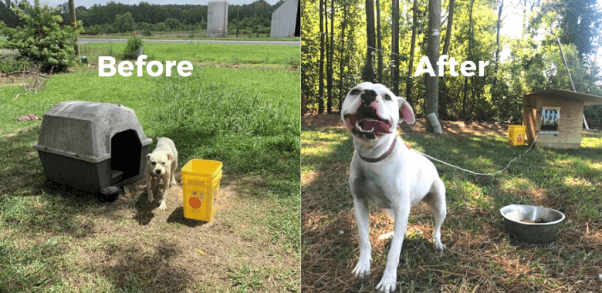
What is frustrating about tethering laws, according to fieldworkers?
Some jurisdictions allow chaining for only three hours per day, but a typical animal control officer cannot realistically enforce this law by spending three hours waiting to see if a tethered dog is taken indoors. Also, some people who live in a place with an anti-tethering ordinance keep their dogs in pens that provide them with just as little space as they’d have on a tether, so there need to be ordinances governing how large a pen must be—otherwise it’s no better than chaining.
What is the goal of PETA’s straw delivery program? Why is straw better than blankets or other bedding for dogs kept outdoors?
The goal of the program is to deliver free straw to “backyard dogs” in need in order to help them be more comfortable in the winter. People in the community can visit PETA’s headquarters and take home free straw, and PETA staffers volunteer on the weekends to deliver straw to dogs in areas where they know there’s a high concentration of chained dogs. If it rains and it’s cold, a blanket or other cloth bedding becomes little better than a piece of ice—but straw will remain dry. Straw helps dogs retain their body heat, and they enjoy rolling and playing in it.
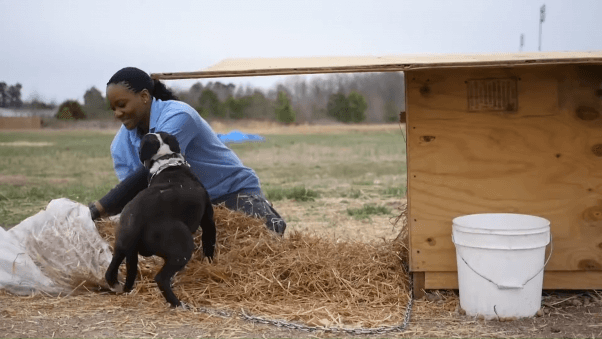
What is heartworm disease, and how do dogs get it?
Heartworms are parasites that are transmitted by mosquitoes and grow and live inside the heart, lungs, and associated blood vessels of dogs. Dogs get it from being outside in certain areas and not receiving preventive medication, and it can be lethal.
According to PETA’s fieldworkers, what are some of the risks that “outdoor cats” and feral cats face? What diseases can they contract and spread if they’re not vaccinated?
Unvaccinated “outdoor cats” and feral cats can carry feline leukemia and feline AIDS, which they can spread to other felines. Like dogs kept outdoors, they’re forced to live through all weather extremes, and they’re susceptible to being hit by cars, abused by cruel humans, or attacked by other free-roaming cats, dogs, or wildlife. If they get hurt or sick, they often go without veterinary care, so many can languish with wounds or infections for days after being injured or attacked.
Why is spaying and neutering cats especially important?
One unspayed cat can produce more than 200 cats in one year. Cats reproduce faster and at a much younger age than dogs.
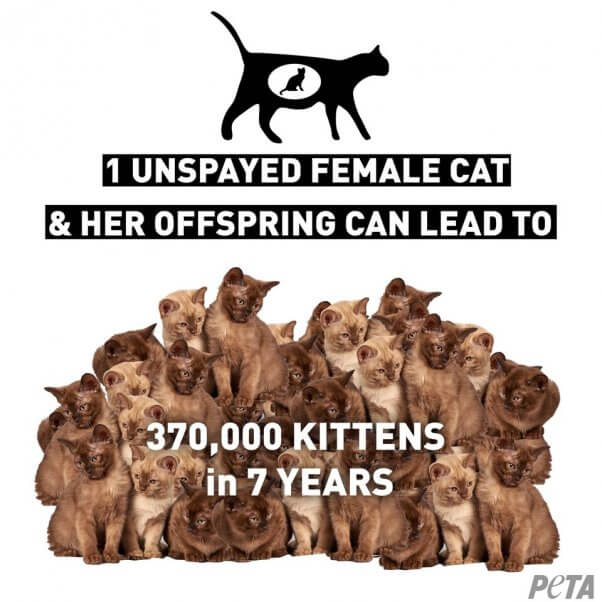 What can you do if you spot neglect or cruelty to animals or an animal who is suffering?
What can you do if you spot neglect or cruelty to animals or an animal who is suffering?
Call local authorities. If authorities are unresponsive, you can call PETA. You can even make anonymous reports in most cases.
Describe Zena the dog’s story in the film. What was her life like? How did PETA help alleviate her suffering?
Zena spent years chained in a backyard, where she was tormented by biting flies (causing flystrike wounds on her ears), fleas, and mosquitoes. She was so neglected by her owners that her teeth were ground down to the root. (Dogs may chew on hard objects like their doghouses or water bowls out of extreme frustration; they may chew their skin to alleviate itching caused by fleas, ticks, and flies; or they may eat rocks and dirt as a result of malnutrition—all of which can cause their teeth to be worn down.) Zena was also emaciated, her hair was falling out, and she was entirely unfamiliar with being petted when fieldworkers tried to stroke her. PETA provided Zena with a sturdy doghouse to make living outdoors more bearable and attempted to rehabilitate her after her owners surrendered her. However, her health continued to deteriorate, so she was peacefully euthanized.
Describe Edith the dog’s story in the film. What was her life like before PETA helped her? What is her life like now?
Edith was chained outdoors for nearly a decade. Fieldworker Jes had been visiting her since she was a puppy, but after she went missing, Jes assumed that she had died. Several years later, though, while reviewing another fieldworker’s photos of a dog named Fluffy, Jes realized that Fluffy was actually Edith. Edith’s owners finally surrendered her to PETA, and Jes adopted her. Edith now lives indoors with her family and has all her needs met.

In your own words, describe the animal overpopulation and homelessness crisis. What causes it? Why is it a problem? How can it be solved?
On any given day in the U.S., there are an estimated 70 million homeless dogs and cats struggling to survive. They are a result of people’s failure to spay or neuter their animal companions, allowing them to bring more animals into a world that already has more dogs and cats than there are loving homes for them. Some were abandoned, and many are the offspring of abandoned animals whose guardians moved and left them behind, dropped them by the side of the road when they could no longer care for them, or just didn’t want them anymore. Dogs and cats are domesticated animals who depend on humans to meet their needs for food, water, veterinary care, shelter, and safety and cannot survive for long on their own. The suffering and deaths of homeless animals is 100% preventable through spaying and neutering.
In your own words, explain why “no-kill” policies are misleading and harmful to animals.
When “no-kill” animal shelters and rescue groups are filled to capacity, which is almost always, they’re left with two options: turn away more animals than they take in or warehouse animals, often in substandard, filthy, and severely crowded conditions, for weeks, months, or even years on end. Most, if not all, of the animals who are turned away from such facilities still face untimely deaths—just not at these facilities.
In your own words, explain why spaying and neutering is so important to the health of animals.
Spaying eliminates the stress and discomfort that females endure during heat periods, eliminates the risk of uterine cancer, and greatly reduces the risk of mammary cancer. Neutering makes males far less likely to roam or fight, prevents testicular cancer, and reduces the risk of prostate cancer. Altered animals are less likely to contract deadly, contagious diseases, such as feline AIDS and feline leukemia, that are spread through bodily fluids.
The single most important thing that we can do to spare cats and dogs all the suffering and death that their overpopulation causes is to sterilize them. Spaying and neutering are routine, affordable surgeries that can prevent thousands of animals from being born, only to suffer and struggle to survive on the streets, be abused by cruel or neglectful humans, or be euthanized in animal shelters for lack of a loving home.
*****
Because Breaking the Chain is jam-packed with compelling information and heart-wrenching anecdotes, we couldn’t cover everything in it with these discussion questions. So why not take some time after finishing the film to discuss key takeaways and lasting impressions as well as what students were surprised to find out, how their perception of PETA has changed, what they now know about the homeless-animal crisis, and how they intend to apply what they learned from the film in their own lives? Your students may feel motivated to become more active in helping animals, so discuss ways they can get more involved and go over what to do if they see an animal in need.
Use the following TeachKind lessons and activities to continue discussing the companion animal overpopulation crisis and actions your students can take to help alleviate it:
- Challenging Assumptions: A Social Justice Curriculum
- Part 3 of Challenging Assumptions is a service-learning project that requires students to identify an animal-related problem in their community and research, design, and execute a possible solution. Dog chaining is prevalent throughout the country and a problem your students might choose to help solve.
- Debate Kit: Are ‘No-Kill’ Policies Killing Animals?
- How Your School Can Help Chained Dogs
- 6 Ways Your Class Can Help Homeless Animals
- Teach the Importance of Community Service
*****
As discussed in the film, much of the work that needs to be done to help end the companion animal overpopulation crisis involves challenging societal norms, such as the misguided belief that some animals are to be loved and cared for while others are to be treated like property and used for personal gain. TeachKind’s social justice–themed curriculum Challenging Assumptions is the perfect tool for helping your students examine current moral dilemmas, move beyond any incorrect assumptions that they may have made about other sentient beings, and become more perceptive, thoughtful, and analytical about the reasons why humans engage in certain behavior. After your students watch Breaking the Chain, suggest that they tackle the widespread and serious issues of animal homelessness and neglect.